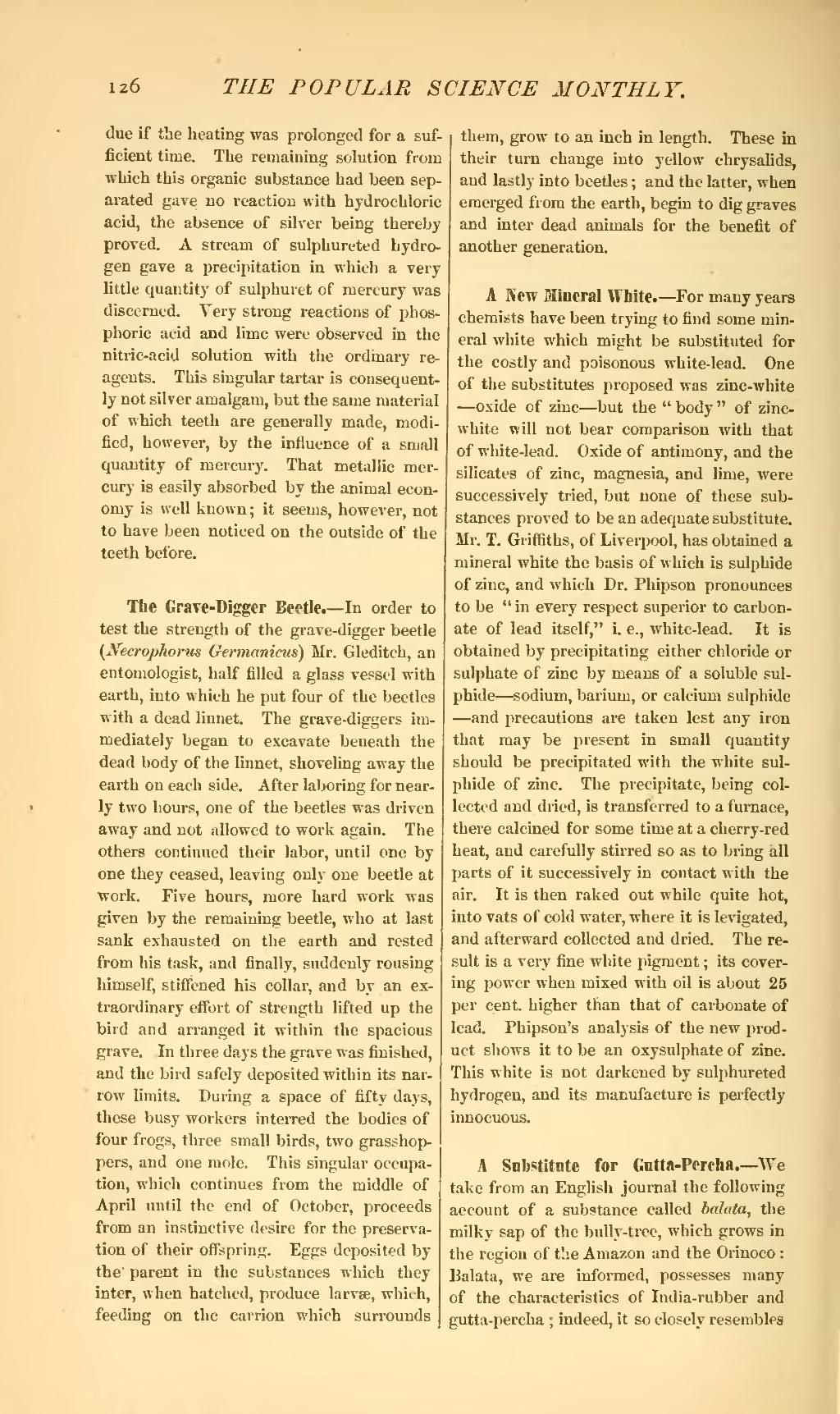due if the heating was prolonged for a sufficient time. The remaining solution from which this organic substance had been separated gave no reaction with hydrochloric acid, the absence of silver being thereby proved. A stream of sulphureted hydrogen gave a precipitation in which a very little quantity of sulphuret of mercury was discerned. Very strong reactions of phosphoric acid and lime were observed in the nitric-acid solution with the ordinary reagents. This singular tartar is consequently not silver amalgam, but the same material of which teeth are generally made, modified, however, by the influence of a small quantity of mercury. That metallic mercury is easily absorbed by the animal economy is well known; it seems, however, not to have been noticed on the outside of the teeth before.
The Grave-Digger Beetle.—In order to test the strength of the grave-digger beetle (Necrophorus Germanicus) Mr. Gleditch, an entomologist, half filled a glass vessel with earth, into which he put four of the beetles with a dead linnet. The grave-diggers immediately began to excavate beneath the dead body of the linnet, shoveling away the earth on each side. After laboring for nearly two hours, one of the beetles was driven away and not allowed to work again. The others continued their labor, until one by one they ceased, leaving only one beetle at work. Five hours, more hard work was given by the remaining beetle, who at last sank exhausted on the earth and rested from his task, and finally, suddenly rousing himself, stiffened his collar, and by an extraordinary effort of strength lifted up the bird and arranged it within the spacious grave. In three days the grave was finished, and the bird safely deposited within its narrow limits. During a space of fifty days, these busy workers interred the bodies of four frogs, three small birds, two grasshoppers, and one mole. This singular occupation, which continues from the middle of April until the end of October, proceeds from an instinctive desire for the preservation of their offspring. Eggs deposited by the' parent in the substances which they inter, when hatched, produce larvæ, which, feeding on the carrion which surrounds them, grow to an inch in length. These in their turn change into yellow chrysalids, and lastly into beetles; and the latter, when emerged from the earth, begin to dig graves and inter dead animals for the benefit of another generation.
A New Mineral White.—For many years chemists have been trying to find some mineral white which might be substituted for the costly and poisonous white-lead. One of the substitutes proposed was zinc-white—oxide of zinc—but the "body" of zinc-white will not bear comparison with that of white-lead. Oxide of antimony, and the silicates of zinc, magnesia, and lime, were successively tried, but none of these substances proved to be an adequate substitute. Mr. T. Griffiths, of Liverpool, has obtained a mineral white the basis of which is sulphide of zinc, and which Dr. Phipson pronounces to be "in every respect superior to carbonate of lead itself," i. e., white-lead. It is obtained by precipitating either chloride or sulphate of zinc by means of a soluble sulphide—sodium, barium, or calcium sulphide—and precautions are taken lest any iron that may be present in small quantity should be precipitated with the white sulphide of zinc. The precipitate, being collected and dried, is transferred to a furnace, there calcined for some time at a cherry-red heat, and carefully stirred so as to bring all parts of it successively in contact with the air. It is then raked out while quite hot, into vats of cold water, where it is levigated, and afterward collected and dried. The result is a very fine white pigment; its covering power when mixed with oil is about 25 per cent, higher than that of carbonate of lead. Phipson's analysis of the new product shows it to be an oxysulphate of zinc. This white is not darkened by sulphureted hydrogen, and its manufacture is perfectly innocuous.
A Substitute for Gutta-Percha.—We take from an English journal the following account of a substance called balata, the milky sap of the bully-tree, which grows in the region of the Amazon and the Orinoco: Balata, we are informed, possesses many of the characteristics of India-rubber and gutta-percha; indeed, it so closely resembles
